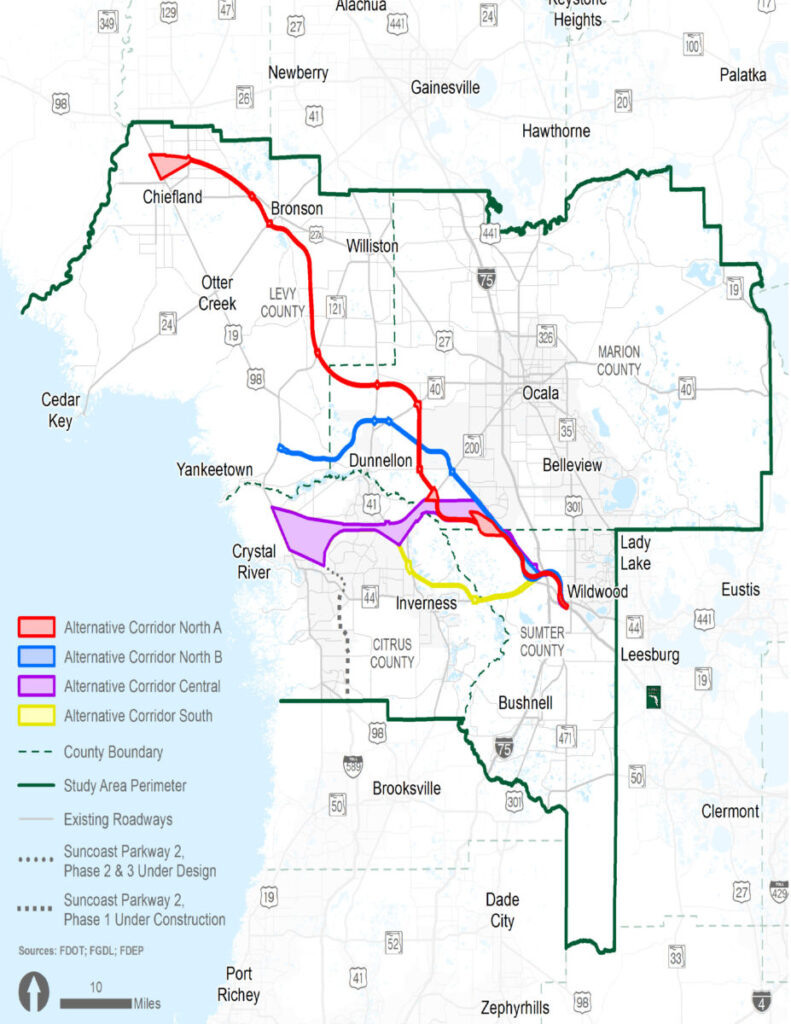It isn’t pretty
The summary turnpike screening report is in.

The Rainbow River near City Beach on Tuesday, Feb. 1. [Alan Youngblood/Special to Ocala Style]
The study area covers four potential routes through Citrus, Levy, Marion, and Sumter Counties.
At the inception of the study, it was noted that “the heaviest travel demand in the study area occurs on I-75, Florida’s Turnpike, and segments of SR44/US41, SR 40, US 27, US 301, SR 35, and SR 50 causing these roadways to operate below FDOT Level of Service (LOS) targets” and that there was “need for additional capacity to relieve the existing congested roadway network in the study area” because substantial growth was projected for these areas in the next twenty to thirty years.
The report estimated “population and employment within the study area will grow from 2015 levels by 53 percent and 72 percent in 2050, respectively. Future growth is expected to increase the travel and freight demand by more than 50 percent by 2050 and consequently increase congestion on the roadway network in the study area. The forecasted growth in travel and freight demand will occur in urbanized areas and near activity centers and will significantly affect mobility for people and goods in the study area. Thus, there is a need to address growth in transportation demand in the project area.”
A 243-page summary screening report published at the end of January gives a glimpse into the environmental impact of each of the proposed routes being considered.
This initial screening process allowed for approximately twenty-nine state and federal agencies to review the proposed project and give feedback.
The report overview of initial feedback from the agencies is broken down into categories, including Social and Economic, Cultural and Tribal, Natural, Physical, and Special Designations.
Each organization reviewed the proposed plans and scores the degree of effect, assigning the categories a score ranging from 0 (No effect, which means there is no community opposition to the proposal, and no adverse effects will be felt), to 1 (Enhanced effect, which means the communities affected by the proposal supports it, and the project will have a positive effect on the area), to a 5 (Potential Dispute, which means there is strong community opposition, the project is not in line with local comprehensive plans, and it will have a negative effect on the area).
Four Gazette reporters each took a route and wrote summaries of what they read. Links to all four stories on each respective route are provided below.

One thing to note in the analysis of each corridor, the study assigned “a minimum width of 1,000 feet for the purpose of evaluating potential impacts and allowing flexibility for development of narrower corridor alignments.”
The estimation of population and household numbers within that corridor are included in each corridor report. However, Angela Starke, a spokesperson for FDOT explained “A parcel-based analysis with an accurate number of households within each corridor is being performed and will be documented” in a future report.
Starke added that “even if households are within the selected corridor, that does not mean that the households would be impacted by a future roadway project. The potential impact on households, including relocations and access to properties, would be identified, documented, and presented to the public during the PD&E phase.”
“The Northern Turnpike Extension project includes a robust public engagement effort, which will continue throughout all phases. A webpage on Florida’s Turnpike Enterprise’s website, www.floridasturnpike.com/NTE, provides project updates, including upcoming public meetings,” said Starke.
Alternative Corridor North A
Alternative Corridor North B
Alternative Corridor Central
Alternative Corridor South





